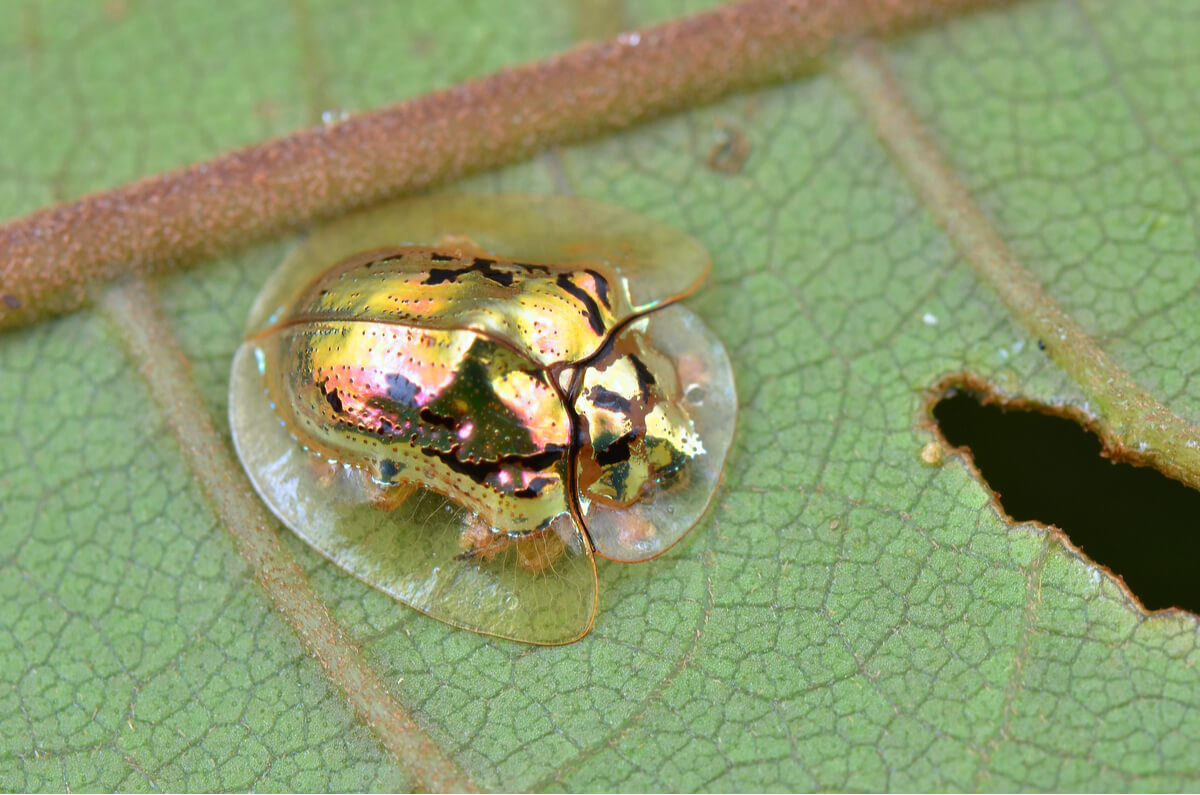The Shiny Bodies of Mirror Beetles Don't Act as Camouflage


Written and verified by the biologist Cesar Paul Gonzalez Gonzalez
Camouflage is a fairly common anti-predator strategy in insects, as it allows them to go unnoticed by simply remaining static. However, some species, such as mirror beetles, are characterized by shiny bodies, which were thought to act as camouflage.
Initially, it was thought that mirror beetles could use their bodies as if they were a mirror reflecting their surroundings. In this way, they would be able to remain unnoticed by predators. However, a recent study seems to indicate that these insects don’t use their shiny bodies as camouflage. Continue reading and discover what this curious characteristic is used for.
Who are mirror beetles?
Mirror beetles belong to the order Coleoptera, which includes other well-known animals such as weevils, ladybugs, and oilbugs. Their body has an oval shape and a smooth texture, which allows them to reflect light as if they were a mirror. This, together with the bright colors it usually displays (green, red, blue, among others), gives its body a metallic tone.
The body of these insects is composed of three areas: the head, thorax and abdomen. Contrary to popular belief, the only visible region is the head, while the thorax and abdomen are usually covered by hardened wings called elytra. In fact, the shiny metallic coloration is only seen on the head and elytra, as the rest of the body has other shades.
Although they share the same characteristic of reflecting light, mirror beetles don’t belong to the same species. In fact, they don’t even belong to the same families. Because of this, there’s a great variety of sizes and shapes in this group.

Why do mirror beetles glow?
Initially, it was believed that the glow of mirror beetles was a kind of camouflage that allowed them to reflect their surroundings in order to hide. Viewed another way, predators were unable to find the beetles because they only saw a “mirror” reflecting the surroundings. However, there was no research to either affirm or refute this ability.
In 2021, a group of researchers from the University of Melbourne decided to confirm this theory. To do so, they used coleopteran replicas with the same ability to reflect light as mirror beetles, in addition to other replicas that had a more opaque coloration. These replicas were hidden in a forest and several people were asked to try to find them.
The experiment assumed that if the camouflage hypothesis was true, participants should take longer to find the replicas that resembled the mirror beetles. Whereas replicas with opaque colorations would have to be easier to find.
An unexpected result
The results of the experiment astonished the scientists, as it took participants the same amount of time to find both types of replicas. This meant that the shiny bodies of the mirror beetles had no special function as camouflage.
Although this result was all too obvious, humans don’t have the same eyesight as beetle predators. For this reason, there was still a possibility that the camouflage only worked with species that eat beetles.
To remove any doubts, the researchers conducted a second experiment with the same methodology, but now, instead of people, they used birds. As expected, the result of this new test was exactly the same as the previous one. The birds fed equally on both types of replicas, confirming that the shiny body of the mirror beetles did not serve as camouflage.

What’s the shiny body of the beetles for?
Despite the results obtained in this study, it’s clear that the shiny body of the mirror beetles has a function that’s still unknown. This is known because nature only favors characteristics that are advantageous to the species.
In fact, a 2017 paper published in Scientific Reports mentioned that the shiny body of some beetles could serve as an aposematic signal. In other words, they help warn predators that the species tastes bad and shouldn’t be eaten.
This effect is already visible in other species, such as coral snakes, which sport colorful skin that warns predators of their toxicity. The goal of aposematic signals is to reduce predation by means of colorful warnings, which fits perfectly with the shiny appearance of the mirror beetle.
Although the shiny bodies of mirror beetles don’t serve as camouflage, this doesn’t mean that they don’t have a purpose. In nature, most of the traits such as these offer advantages to the organism. The physical appearance of animals isn’t random, but is well adapted to their environment to try to ensure their survival.
Camouflage is a fairly common anti-predator strategy in insects, as it allows them to go unnoticed by simply remaining static. However, some species, such as mirror beetles, are characterized by shiny bodies, which were thought to act as camouflage.
Initially, it was thought that mirror beetles could use their bodies as if they were a mirror reflecting their surroundings. In this way, they would be able to remain unnoticed by predators. However, a recent study seems to indicate that these insects don’t use their shiny bodies as camouflage. Continue reading and discover what this curious characteristic is used for.
Who are mirror beetles?
Mirror beetles belong to the order Coleoptera, which includes other well-known animals such as weevils, ladybugs, and oilbugs. Their body has an oval shape and a smooth texture, which allows them to reflect light as if they were a mirror. This, together with the bright colors it usually displays (green, red, blue, among others), gives its body a metallic tone.
The body of these insects is composed of three areas: the head, thorax and abdomen. Contrary to popular belief, the only visible region is the head, while the thorax and abdomen are usually covered by hardened wings called elytra. In fact, the shiny metallic coloration is only seen on the head and elytra, as the rest of the body has other shades.
Although they share the same characteristic of reflecting light, mirror beetles don’t belong to the same species. In fact, they don’t even belong to the same families. Because of this, there’s a great variety of sizes and shapes in this group.

Why do mirror beetles glow?
Initially, it was believed that the glow of mirror beetles was a kind of camouflage that allowed them to reflect their surroundings in order to hide. Viewed another way, predators were unable to find the beetles because they only saw a “mirror” reflecting the surroundings. However, there was no research to either affirm or refute this ability.
In 2021, a group of researchers from the University of Melbourne decided to confirm this theory. To do so, they used coleopteran replicas with the same ability to reflect light as mirror beetles, in addition to other replicas that had a more opaque coloration. These replicas were hidden in a forest and several people were asked to try to find them.
The experiment assumed that if the camouflage hypothesis was true, participants should take longer to find the replicas that resembled the mirror beetles. Whereas replicas with opaque colorations would have to be easier to find.
An unexpected result
The results of the experiment astonished the scientists, as it took participants the same amount of time to find both types of replicas. This meant that the shiny bodies of the mirror beetles had no special function as camouflage.
Although this result was all too obvious, humans don’t have the same eyesight as beetle predators. For this reason, there was still a possibility that the camouflage only worked with species that eat beetles.
To remove any doubts, the researchers conducted a second experiment with the same methodology, but now, instead of people, they used birds. As expected, the result of this new test was exactly the same as the previous one. The birds fed equally on both types of replicas, confirming that the shiny body of the mirror beetles did not serve as camouflage.

What’s the shiny body of the beetles for?
Despite the results obtained in this study, it’s clear that the shiny body of the mirror beetles has a function that’s still unknown. This is known because nature only favors characteristics that are advantageous to the species.
In fact, a 2017 paper published in Scientific Reports mentioned that the shiny body of some beetles could serve as an aposematic signal. In other words, they help warn predators that the species tastes bad and shouldn’t be eaten.
This effect is already visible in other species, such as coral snakes, which sport colorful skin that warns predators of their toxicity. The goal of aposematic signals is to reduce predation by means of colorful warnings, which fits perfectly with the shiny appearance of the mirror beetle.
Although the shiny bodies of mirror beetles don’t serve as camouflage, this doesn’t mean that they don’t have a purpose. In nature, most of the traits such as these offer advantages to the organism. The physical appearance of animals isn’t random, but is well adapted to their environment to try to ensure their survival.
All cited sources were thoroughly reviewed by our team to ensure their quality, reliability, currency, and validity. The bibliography of this article was considered reliable and of academic or scientific accuracy.
- Waldron, S. J., Endler, J. A., Valkonen, J. K., Honma, A., Dobler, S., & Mappes, J. (2017). Experimental evidence suggests that specular reflectance and glossy appearance help amplify warning signals. Scientific reports, 7(1), 1-10.
- Franklin, A. M., Rankin, K. J., Ospina Rozo, L., Medina, I., Garcia, J. E., Ng, L., … & Stuart‐Fox, D. (2022). Cracks in the mirror hypothesis: high specularity does not reduce detection or predation risk. Functional Ecology, 36(1), 239-248.
- Dakari, A., Triantafillou-Rundell, M., Papadopoulos, A., Skoulas, E., Stratakis, E. & Trichas, A. (2019). Elytral UV, visible and infrared reflectivity and absorbance on mountaintop beetles: the case of Dendarus spp. (Coleoptera: Tenebrionidae) of lowland and high elevations of Crete. Conference: 14th ICZEGAR – International Congress on the Zoogeography and Ecology of Greece and Adjacent Regions, 27-30.
This text is provided for informational purposes only and does not replace consultation with a professional. If in doubt, consult your specialist.








